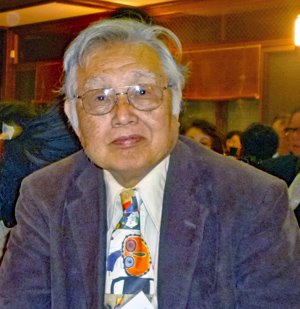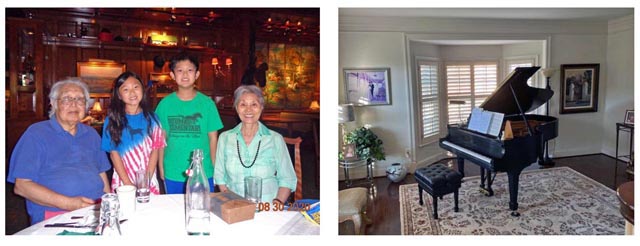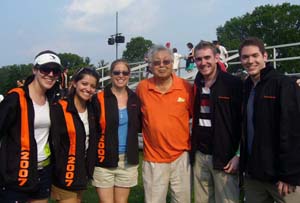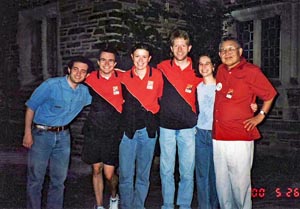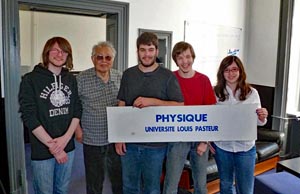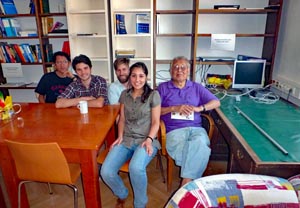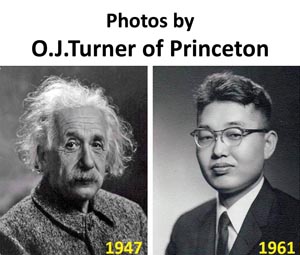Photo-biography ofYoung Suh Kim
|
Childhood (1935-1946)
- I was born in 1935 at a Korean village called Sorae, where
Koreans set up their first Presbyterian church in 1884. Horace
Underwood was the first American Presbyterian missionary who came to
Korea in 1885. Upon hearing about this church, he went to Sorae
and noted that this village is near a beautiful scenic beach called
Kumipo. He built his house there. Then, many other Americans
came to Kumipo to build their summer houses.
My grandfather was one of Underwood's trusted Korean friends. He was a well-to-do landlord, and took care of Underwood's properties at Sorae and Kumipo while he was busy in the capital city of Seoul. Underwood set up a Christian college in Seoul which became one of the leading universities in Korea, called Yonsei University.
I attended this Sorae church when I was a child, and grew up in the thoroughly Christian environment.
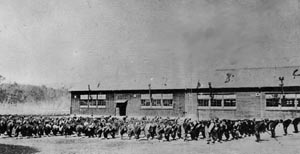
Click here to expand this photo.-
Elementary school in Sorae under Japanese occupation. Students and teachers
had to bow toward the Japanese emperor in the morning before the school hours.
- Korea was occupied by Japanese military imperialists from 1910 to
1945. I had to attend my elementary school run by Japanese. We had
to speak Japanese while in school, and bow toward East
(Japanese Emperor in Tokyo) every morning before school hours.
Here is a photo of my elementary
school in Sorae with students and teachers.
- Unfortunately, Korea became divided in 1945 after World War II, and
the village of Sorae is now under the control of the North Korean
regime which was installed in 1948 by Joseph Stalin of the Soviet
Union. My family moved to Seoul in 1946 before 1948.
- Do you know how Korea was divided in 1945?
Click here.

- I met Richard Underwood in Urbana, Illinois, USA (2003).
- In 2003, I was fortunate enough to meet Richard Underwood, Horace Underwood's
youngest grandson, in Urbana, Illinois, USA. We talked about Sorae and Kumipo.
He was a Korean-speaking member of the American team at the Panmunjon Cease-Fire
talks (1951-53) during the Korean war (1950-53).
He is the author of the
NLL, the dividing like between North and South in the West Sea of Korea. He was
was eager to see his house at Kumipo from the South.
- Click here for my Korean background.
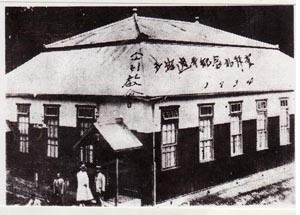
|
Click here for the history of this church. |
Teenager (1946-1954)
- In Seoul, I finished my elementary school and went to six
years of high school education from 1948 to 1954.
- Alas, the Korean
War broke out in 1950 and lasted until 1953. The school campus was
damaged and the students had to study at temporary places until the
cease fire was signed in July of 1953.
Click here for my stories of the Korean war (1950-53).
- These days, it is meaningless to talk about one's high school
background, but everybody thinks his/her school is best in the world.
I have a good reason to say that I attended the best high school in
the world. Click here for my reasoning.
Click here for
comparable high schools in the world.
Another excellent high school in Budapest, Hungary.
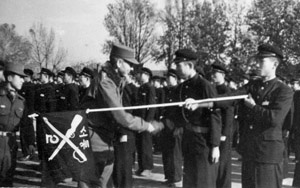 Click here to expand this photo.
Click here to expand this photo.
-
In this photo of 1954, I am shaking hands with General Maxwell
Taylor who was the commander of the U.S. Forces in Korea. Under him
were more than 300,000 combat-ready American troops.
General Taylor was a scholarly man and was keenly interested in Korea's educational system. He wanted to visit the best high school in Korea. He asked his Korean secretary which school to visit. The Korean secretary told Taylor about the high school he attended. He is also in this photo (far left).
- Click here for my high-school diary.
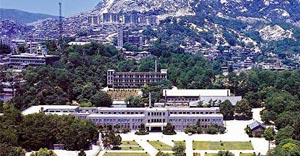 Click here to expand this photo.
Click here to expand this photo.
|
|
Undergraduate Years (1954-1958)
- In September of 1954, I came to the United States to become a
freshman at the Carnegie Institute of Technology (now called Carnegie
Mellon University) in Pittsburgh, Pennsylvania.
The life was not easy for me, but I worked hard enough to get excellent grades.
- On March 12, 1958, I received a letter from Princeton University
telling me I was one of twelve students admitted to the graduate
program in physics. This was the happiest day in my life. Going
to Princeton meant working with Albert Einstein, even though he
died in 1955, three years before 1958.
- Click here for my photos form
Pittsburgh.
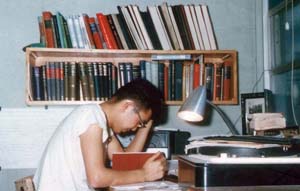 Click here to expand this photo.
Click here to expand this photo.
|
Princeton Years (1958-1962)
- In July of 1958, I went to Princeton for my graduate study.
Thanks to my solid high-school and undergraduate backgrounds, I
completed my PhD degree in three years, but I was asked to stay
there for one additional year as a post-doctoral fellow.
In this photo of 1961, I am making preparations for my third paper to be published in the Physical Review, the standard journal of the American physical Society.
- I have many interesting photos from Princeton.
- Princeton campus.
- Parades of Princeton Graduates Lifestyle of affluent Americans.
- Princeton people. I met many interesting people in and from Princeton.
- Click here for the fortune
I got from Princeton.
- New York City.
While in Princeton, I used to go to New York City often for excitements. It was one
hour of train ride. Click here for my New York page.
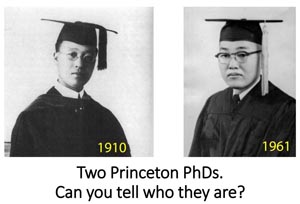
|
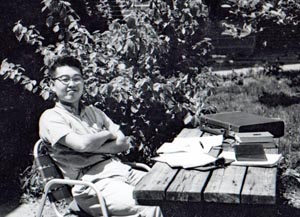
|
Period of Adjustments (1962-1966)
- In July of 1962, I became an assistant professor of physics at
the University of Maryland, near Washington, DC. This is a photo of
the physics faculty taken in the spring of 1963, and I am the youngest
person in this photo. The life was not easy for me in the highly
competitive academic world, where everybody is afraid of his/her
colleague becoming more famous than himself/herself.
- This is a human nature which can be described as
Herod Complex.
Among my colleagues, there were several people who got turned down from
Princeton and went to other good graduate schools. Those people were
extremely nasty to me. However, I always got help from appropriate
persons whenever I was in difficult positions. The point is that I
pursued my own research line strange to others.
What is the job of the youngest faculty member? In September of 1962, Paul A. M Dirac (Nobel 1933) visited the University of Maryland at the invitation of John S. Toll, the chairman of the Department of Physics. Toll assigned me to serve as the personal assistant to Dirac. This gave me the valuable opportunity to learn physics directly from him. Click here to see what learned from him.
 Click here to expand this photo.
Click here to expand this photo.
- The most rewarding aspect of my life at the University of Maryland
is that the campus is near the city of Washington, DC.
There are many politicians in the Greater Washington area, but there are far more scientists in this area. They are providing necessary wisdom to the government. Here are the photos from this interesting city.
- Even though I am away from Princeton, I used to think the ultimate
wisdom in physics comes from Princeton. However, in 1965, I realized that
Princeton is not necessarily the holy place in physics.
Click here for my explanation.
This does not mean that I lack respect for Princeton's historical figures such as Albert Einstein and Eugene Wigner. I do not have to mention those Princeton people I dislike, because their names do not exist in the history of physics.
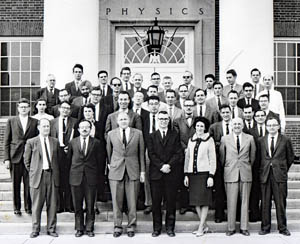 Click here to expand this photo.
Click here to expand this photo.
|
Years of Struggle (1966-1979): Most Valuable Years!
- After losing my confidence in Princeton's leadership [which did not include
Eugene Wigner (Nobel 1963)], I decided to construct my own research line. It was
a struggle.
- I continued studying
Wigner's 1939 paper on the inhomogeneous Lorentz group. I started
studying this paper when I was a student at Princeton. It was a
frustrating experience because people did not know how to use this
mathematical formalism for understanding physics.
- I noticed also a blank point in history. During the early years of
the 20th Century, Niels Bohr was worrying about the hydrogen atom, while
Einstein was interested in how things look to moving observers. They met
occasionally to discuss physics. If they talked about moving hydrogen atoms,
there are no written record on this issue.
- The question then is whether the Bohr-Einstein issue of the hydrogen can be interpreted in terms of the scientific language Wigner constructed in 1939.
- I continued studying
Wigner's 1939 paper on the inhomogeneous Lorentz group. I started
studying this paper when I was a student at Princeton. It was a
frustrating experience because people did not know how to use this
mathematical formalism for understanding physics.
- We can summarize what I said above into the following figure.
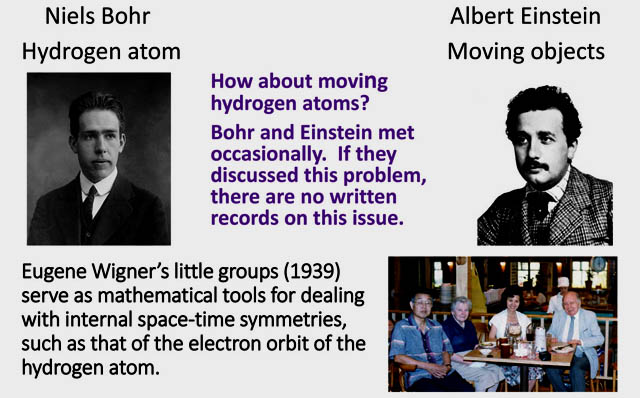
Photos of Bohr and Einstein are from the public domain. In 1978, with my younger colleagues, I wrote a paper saying that Wigner's 1939 paper plays an essential role in studying moving quantum bound states, like the hydrogen atom or the proton in the quark model. I submitted this paper to the Journal of Mathematical Physic in late 1978, and it appeared in the Journal in early 1979. Here is the paper.
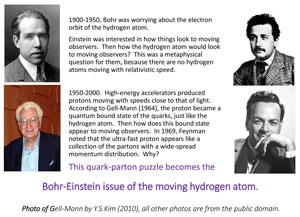 Click here to expand this figure.
Click here to expand this figure.
- If Bohr and Einstein did not discuss the moving hydrogen atom, it is
understandable. There were and still are no hydrogen atoms fast enough
to show the effect of Einstein's relativity.
- During the latter half of the 20th Century, high-energy accelerators
started producing protons moving with speeds close to that of light.
However, the proton is not a hydrogen atom. In 1964, Murray Gell-Mann
formulated the quark model of hadron where the proton is a quantum bound
state of more fundamental particles called "quarks." In this way,
Gell-Mann was able to explain the mass spectra of other particles
appearing in high-energy physics.
While the proton is a quantum bound state, just like the hydrogen atom, it can move with speed close to that of light. For this ultra-fast proton, Feynman observed a number of peculiarities. This observation is called "Feynman's parton picture." Thus the Bohr-Einstein issue of the hydrogen atom is translated into the question of Gell-Mann's quark model and Feynman's parton picture can be explained in terms of Einstein's relativity.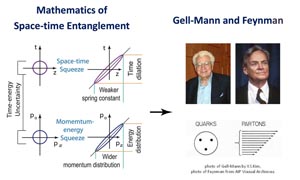 Click here to expand this figure.
Click here to expand this figure.
- Click here for more about
the quark-parton puzzle.
- Click here for the wide-open physics world.
Dirac Years (1979-1986)
- After publishing
my paper on the Poincaré group
in 1979, I found out I was not the first person to worry about moving
hydrogen atom. I then studied the papers written by early pioneers.
Paul A. M. Dirac (Nobel 1933) devoted much of his professional life to
constructing quantum mechanics in Einstein's relativistic world.
He wrote beautiful sentences, and his papers are like poems, but there are no figures in his papers. I then translated Dirac's poems into cartoons and illustrations. With those figures, it is easy to integrate Dirac's papers into one. The net effect is then the Bohr-Einstein issue of how the hydrogen atom appears to moving observers, or how the hydrogen atom appears when it moves fast.
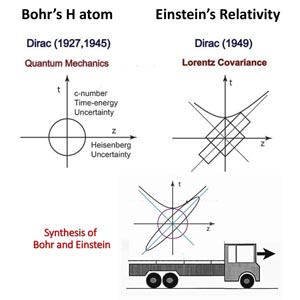 Click here to expand this figure.
Click here to expand this figure.
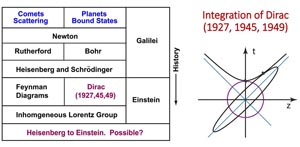 Click here to expand this figure.
Click here to expand this figure.
- In this figure, the hyperbola is
for Einstein's relativity and the
circle is quantum mechanics of the proton or the hydrogen atom
(localized probability distribution according to quantum mechanics).
It has a probability distribution along the
spacial axis (according to Bohr, Schroedinger, and Heisenberg). It
also has a distribution along the time axis according to Dirac.
When the system moves, the hyperbola remains the same according to Einstein. On the other hand, the circle becomes squeezed to ellipse, while maintaining the contact point with the hyperbola.
- Then where does this result stand in history? Historically
our unified understanding of scattering and bound states has
been very brief. Comets (scattering) and planets (bound states)
were quite different until Isaac Newton produced his equation of
motion. In atomic and nuclear physics, they were separate issues
until Schroedinger and Heisenberg produced their formulas.
In Einstein's world, they are again separate issues. For scattering problems, quantum field theory is a satisfactory scheme for dealing with scattering problems. For the bound-state, we have to deal with the problem using the mathematical procedure given here.
The question then is whether the scattering and bound states in Einstein's relativistic world can be derived from the same set of equations. The answer is YES. This set is called the inhomogeneous Lorentz group or the Poincaré group. With my younger colleagues, I published many articles and books on this subject. My latest book is entitled "Physics of the Lorentz group: Beyond High-energy Physics and Optics," published in 2021 by the British Institute of Physics.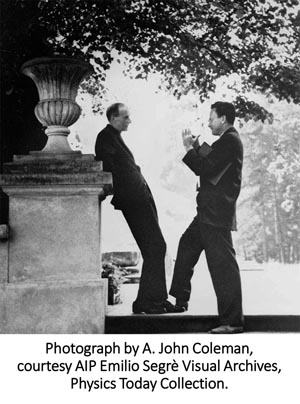 Click here to expand this figure.
Click here to expand this figure.
-
Dirac and Feynman in Poland (1962). Dirac was a poet and Feynman was a
cartoonist. It is fun to translate Dirac's poems into cartoons.
- The mathematics of the circle becoming squeezed into an ellipse
is simple enough.
The question is whether this effect can be
observed in the real world. Indeed, Gell-Mann's quark model
and Feynman's parton picture are routinely observed in high-energy
laboratories. They can be described in terms of this simple
mathematics. Click here for my the
parton file.
- I met Dirac in 1962. I was like Nicodemus meeting Jesus. Who was Nicodemus? Go to the Gospel of John in the New Testament.
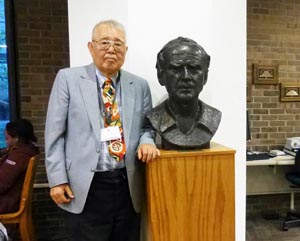
|
|
|
Wigner Years (1986-90)
- Throughout my research life, I was guided by the paper on the
inhomogeneous Lorentz group published in 1939 by Eugene Wigner (Nobel 1963).
He was a professor at Princeton University when I was a student there.
I used to go to him whenever I had questions other professors could not
explain.
- His 1939 paper deals with the internal space-time symmetries of
particles in Einstein's world. A massive particle can be brought
to the frame where it is at rest. In this frame, the particle
exhibits its internal angular momentum called "spin," and its
spin axis can have three different directions. For massless particles,
like photons, the spin can have one direction parallel to its momentum.
This massless particle has an un-observable gauge degrees of freedom.
Wigner's 1939 did not produce a unified picture of these two different
physical phenomena.
- In 1986, with my younger colleagues, I published a paper containing the following
table. This table tells that Wigner's little group unifies the internal space-time
symmetries for both massive and massless particles, as Einstein's
-
E = mc2
unifies the energy-momentum relation.
This table is from one of my papers published in 1986.Contents of Einstein's E = mc2
Particle Massive/Slow between Massless/Fast Einstein Energy
MomentumE = p2/2m E =
(m2 + p2)1/2E = cp Wigner Helicity
spin, GaugeS3
S1 S2Winner's
Little GroupsHelicity Gauge Trans. In 1986, I approached Professor Wigner to tell this story to him. He became very happy and asked me to publish new papers with him. We produced seven papers.
- After publishing my papers with Wigner, I became politically (unfortunate word)
strong enough to publish the following table in
Physical Review Letters.
This table contains my earlier work on the Bohr-Einstein issue
of the Gell-Mann-Feynman issue.
Further Contents of Einstein's E = mc2
Massive/Slow between Massless/Fast Energy
MomentumE = p2/2m Einstein's
E=(m2 + p2)1/2E = cp Helicity
Spin, GaugeS3
S1 S2Wigner's
Little GroupHelicity
Gauge Trans.Hadrons,
Bound StatesGell-Mann's
Quark ModelOne
Lorentz-Covariant
EntityFeynman's
Parton Picture
Click here for further contents of this table.
- Let us translate this table into the plain language:
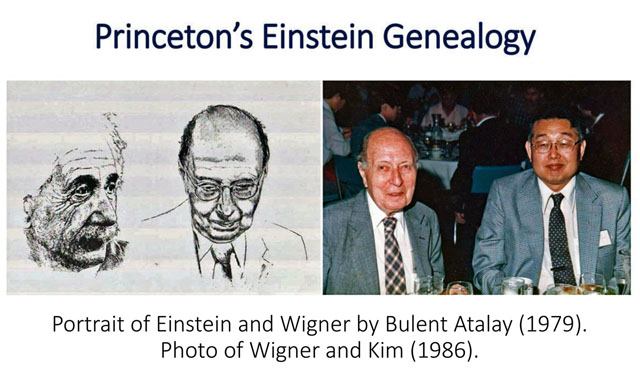
Throughout my academic career, the most important asset has been my graduate and post-graduate education in Princeton (1958-62). I met there Professor Eugene Wigner while I was a student. After coming to Maryland, I continued the research line set up by Wigner. In 1986, I approached him again after doing enough work to tell him what he really wanted to hear. In this way, I published seven papers with Wigner. Thus, it is possible to construct Princeton's Einstein genealogy as shown in this photo.
- Click here for my Wigner file.
- Click here for his little groups
spelled out in his 1939 paper.
- The most rewarding aspect of my association with Wigner was that I could
now act as a Princeton man.
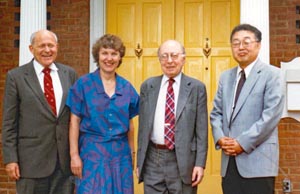
|
|
Optical Sciences (1990-2012)
- In order to study Dirac and Wigner, I had to study the mathematics
of the Lorentz group thoroughly. I noted that the same mathematics is
applicable to optical sciences. It is like the same second order
differential equation applicable to both mechanical and electronic systems
as shown in this figure.
- I first found out the theory of squeezed states of light is a
representation of the Lorentz group. The squeezed state is the two-photo
coherent state which can be interpreted with two coupled oscillators.
- Optical devices, such as lens and cavities, can be described by the Lorentz
group.
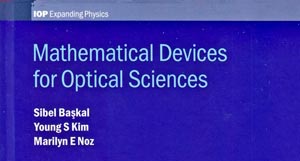
-
This book was published by the IOP (British Institute of Physics).
- In 1963, Paul A. M. Dirac concluded that the two coupled oscillators
lead to the group O(3,2), namely the Lorentz group applicable to three
space-like dimensions and two time-like directions. Needless to say,
the Lorentz group O(3,1) is a subgroup of O(3,2).
- The Poincaré sphere for polarization optics is also a representation of the Lorentz group.
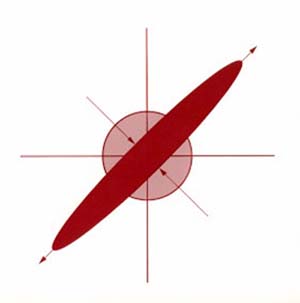
-
Squeeze in phase space, and squeeze in space and time.
- I first found out the theory of squeezed states of light is a
representation of the Lorentz group. The squeezed state is the two-photo
coherent state which can be interpreted with two coupled oscillators.
- It is by now widely established that the Wigner function is the
key scientific language for quantum optics, but not many people
know that those Wigner functions in optics also serve as
the representation of the Lorentz groups, such as O(2,1) and
O(3,2) which are the fundamental languages for the one- and
two-mode squeezed states. When you do squeezed states, you are
doing the Lorentz groups.
On this subject, with Marilyn Noz, I have written a book entitled Phase Space Picture of Quantum Mechanics.
- Click here for more about my efforts in optical sciences.
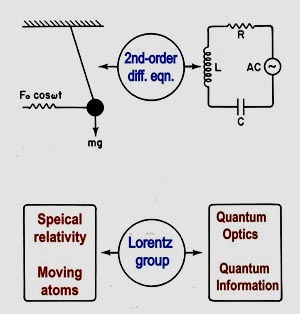
|
Singing Einstein these days.
-
This video about mee from the Marquis Who'a Who mentions Einstein 14 times.
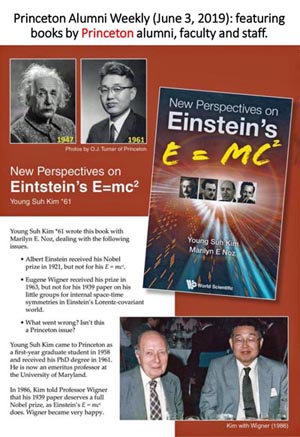 Click here to expand this figure.
Click here to expand this figure.
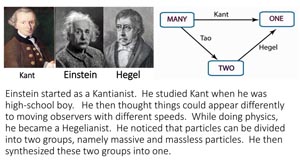 Click here to expand this figure.
Click here to expand this figure.
- Further contents of Einstein's E = mc2.
Click here for the story.
- Einstein's special relativity derivable from two oscillators. Crazy?
I am publishing papers on this subject. Click here for my publication list. - It is said that Einstein was more than a physicist. Then, was he
a politician? No. Was he a philosopher? YES. Then, where is his
coordinate among philosophers. While he was a
high-school student, Einstein studied the books written by Immanuel
Kant. According to Kant, one thing could appear differently depending
on the observer's environment. This is why Einstein worried about
how things look to moving observers.
- On the other hand, most of his scientific achievements are Hegelian.
He synthesized the energy-momentum relation for massive and massless
particles. He also synthesized the wave and particle natures of
the matter in his photo-electric effects. Unlike Kant who wanted
to reduce things to one, Einstein reduced many to two, and then
synthesized them into one. Indeed, this is how the physical laws
have been developed.
Does this mean that both quantum mechanics and special relativity with E = mc2 are derivable from one basket of equations? Go to my publication list for my latest papers on this subject.
- Click here for Einstein
as philosopher. I am not able to see how philosophers can do their
philosophies without understanding physics.
- Einstein is a giant in history. If I talk about him, publishing
companies pay attention to my webpages. Let us see what they say about me.
- Marquis Who's Who
- Wall Street Journal
- Fortune Magazine
-
Research Features.
Click here for the magazine article. - Millenium Magazine
- American Way.
- Hemisphere Magazine.
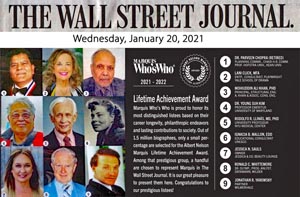
Click here for a larger image.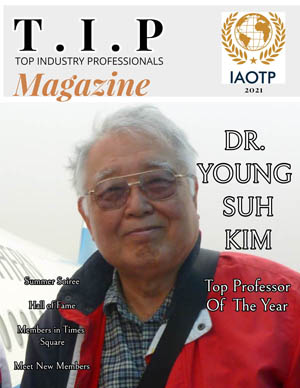
Click here for a larger image. - Marquis Who's Who
- Here is the
cover page of a magazine by the International Asscoation
of Top Professionals. What do they say about me?
-
Let us listen. This video says:
One hundred years ago, Niels Bohr was worrying about the electron orbit of the hydrogen atom, leading to quantum mechanics. Albert Einstein was interested in how things look to moving observers. Then the question is how the hydrogen atom appears to moving observers. Bohr and Einstein met occasionally, but they never discussed this problem. This video says I am the one who settled this issue. Go back to the image given above.
- Toward the end, this video says I had a strong high-school background before coming to the United States from Korea in 1954,
-
Let us listen. This video says:
Personal History
- In Korea, the school year starts in March, while it begins in September
in the United States. Thus, I spent one freshman semester at the Engineering
College of Seoul National University, right after my
high school graduation until I started my freshman year at the
Carnegie Institute of Technology (in Pittsburgh. USA) in September of 1954.
Korea's high schools were and still are single-gender places, according to the rules of Confucius. I went to an all-male high school, and I did not learn how to talk to girls. Click here for an interesting photo.
At that time, Koreans did not trust female engineers. There were not many girls going to engineering colleges. In 1954, my freshman class consisted of 360 students, but there were only 15 girls. Among those girls, one of them appeared attractive to me.
- The following photos show the engineering college and the girl who
attracted my attention.
- I met this girl again in 1963 in Washington. By that time, she needed a
husband, and I needed a wife. We got married. We had our son in 1965,
and he went to Princeton as a freshman in 1983. He got married in 2003.
We now have two grandchildren.
- This is our family photo of 1966.
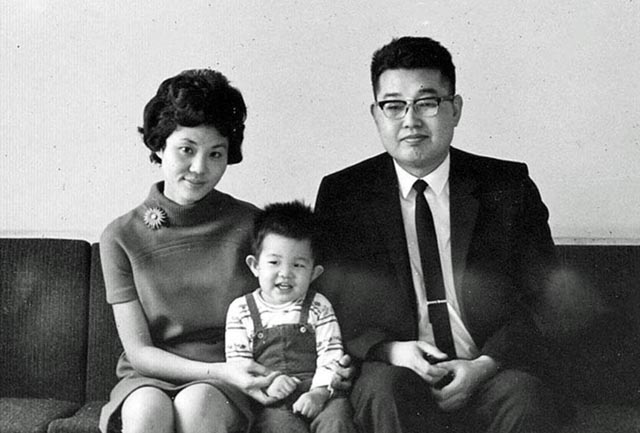
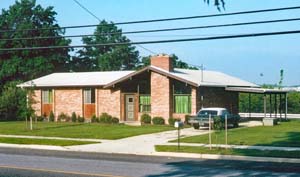
- In 1969, we bought a new house, and
we still live there. This house is about six km from the campus of
the University of Maryland. I could go to my office during the evening
hours.
- Our neighbors are nice people. They help us whenever we need helps. We once invited them to a Korean restaurant in the Washington area.
- There is a treed area near the house, and we see sometimes un-invited guests like this in our backyard.
- Click here for more house photos.
- We now have two grandchildren. Their parents (our son and his wife)
are doing well. In 2020, they bought a Steinway piano for our grandchildren.
We are proud of all four of them.
- Click here for webpages for my wife.
Life after 2007
- In 2007, I became a professor emeritus at the Univ. of Maryland.
This could mean a retirement from professional life.
To me, however, it was a beginning of a new life. This means that I have no teaching and other scheduled duties. Thus, I became a full-time researcher, and I now publish books and articles with complete freedom. In addition, I could travel to interesting places in the world.
- I am free to say whatever I want to say. You may be interested in
the books and articles I published in recent years.
Click here for my publications.
- Since there are no scheduled duties, I have been free to travel around
the world and take photos.
Click here for the photos I took from many different countries. - I am now free to talk about Albert Einstein. Talking about Einstein
and other big names used to upset my colleagues and departmental
administrators in the past.
I am now free to talk about Einstein as a philosopher. Then, where is his coordinate among the well-known philosophers? Click here.
- I am free to say whatever I want to say. You may be interested in
the books and articles I published in recent years.
Click here for my publications.
- I realized that the most important aspect of my research has been and
still is to find out about myself, not necessarily about Einstein and others.
- Work Habit. Connect the existing
lakes to build a big canal. Paul A. M. Dirac wrote many papers in order
to make quantum mechanics consistent with relativity. But he never
attempted to combine them to make one big paper. It was a profitable
business for me to combine them into one paper. How could I do what
Dirac could not do? Dirac wrote beautiful sentences, and his papers
are poems. I translated his papers into cartoons (figures). Then
it is easy to combine them into
one picture
- Where do I stand in Physics? After many years
of struggle (before 2000), I found out where I stand in physics.
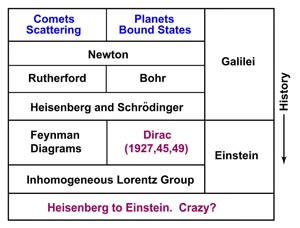
Click here to expand this image. - I then became more
ambitious. I could integrate physics.
- During the 20th Century, scientists developed quantum mechanics (via Bohr and Heisenberg) and relativity (via Einstein). The question is whether these two theories can be derived from one basket of equations. I am writing papers and books on this unthinkable problem. Click here for my recent articles books.
- Work Habit. Connect the existing
lakes to build a big canal. Paul A. M. Dirac wrote many papers in order
to make quantum mechanics consistent with relativity. But he never
attempted to combine them to make one big paper. It was a profitable
business for me to combine them into one paper. How could I do what
Dirac could not do? Dirac wrote beautiful sentences, and his papers
are poems. I translated his papers into cartoons (figures). Then
it is easy to combine them into
one picture
- As a cultured man, I pretend to know about art and music. I can now
say that physics is an art of Harmony and Integration
(Tao and Hegel). Let us see harmony and integration in art and music.
- Harmony in Architecture and Harmony in Physics.
Let us look at the Jefferson Memorial in Washington, DC (USA). It is harmony and
synthesis of Greek columns and Roman dome. This building was John F. Kennedy's favorite
art piece.
- Harmony in Music and Harmony in
Physics. You are invited to my Beethoven
page, Go to his String Quartet No. 4. You will appreciate how important
"harmony" is in music.
- Feynman's One Physics. Feynman is my hero in physics. Like him, I believe in one physics. Richard Feynman was a great American physicist. He received his PhD degree from Princeton in 1942. I maintain a webpage dedicated to him. Click here. Feynman is also a very interesting individual.

Thomas Jefferson Memorial
in Washington, DC. USA.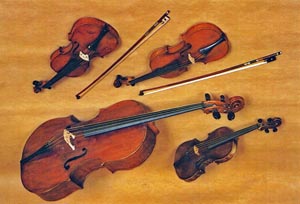
post card from the Beethoven Museum
in Bonn, Germany. - Harmony in Architecture and Harmony in Physics.
Let us look at the Jefferson Memorial in Washington, DC (USA). It is harmony and
synthesis of Greek columns and Roman dome. This building was John F. Kennedy's favorite
art piece.
-
Why am I so crazy about webpages?
Click here.
- Passion for communication. I had
a shortwave radio when I was a high-school student (1951-1954) in Korea.
While listening
to the world, I became eager to talk to the world. The internet technology is
God's best gift to me.
- How do I take photos?
- One crazy webpage.
- Another crazy webpage. People seem to like crazy webpages.

- Passion for communication. I had
a shortwave radio when I was a high-school student (1951-1954) in Korea.
While listening
to the world, I became eager to talk to the world. The internet technology is
God's best gift to me.
- copyright@2021 by Y. S. Kim, unless otherwise specified.
|
